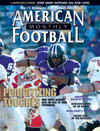AMERICAN FOOTBALL MONTHLY THE #1 RESOURCE FOR FOOTBALL COACHES
Article CategoriesAFM Magazine
|
Defending Third and Longby: David Purdum© More from this issue The option has been grinding you up throughout the whole game. Three yards here, six yards there. It seems like your defense has been facing third and two’s all game. But, on the next possession, you stuff the fullback on first down. Your linebacker makes a good tackle on a quarterback keeper on second down. Finally, it’s third and twelve ... only to have your corner bite on an out-and-up and surrender a 15-yard completion. For a defensive coordinator, there are not many things worse than gift-wrapping a first down on third and long, especially against an option team that is not built to convert in that situation. But it happens to the best of us. Army safeties coach Adam Waugh offers a few tips on how to prevent it from happening to you. In general, there are two basic concepts when defending on third a....The full article can only be seen by subscribers. Subscribe today!
|
|
|||||||
| HOME |
MAGAZINE |
SUBSCRIBE | ONLINE COLUMNISTS | COACHING VIDEOS |
Copyright 2025, AmericanFootballMonthly.com
All Rights Reserved





